实验4
Posted nettj666
tags:
篇首语:本文由小常识网(cha138.com)小编为大家整理,主要介绍了实验4相关的知识,希望对你有一定的参考价值。
1.实验任务1
task1.py
程序源代码:
print(sum) sum = 42 print(sum) def inc(n): sum = n+1 print(sum) return sum sum = inc(7) + inc(7) print(sum)
运行程序截图:

关于问题回答:
2.实验任务2
task2-2.py
程序源代码:
list1 = [1,9,8,4] print(sorted(list1)) print(sorted(list1,reverse = True)) print(sorted(list1,True))
运行程序截图:

关于问题的回答:
task2-3.py
程序源代码:
def func(a,b,c,/,*,d,e,f): return( [a,b,c,d,e,f] ) print(func(1,2,3,d=4,e=5,f=6))
运行程序截图:

3.实验任务3
task3.py
程序源代码:
def solve(a,b,c): delta = b*b -4*a*c delta_sqrt = abs(delta)**0.5 p1 = -b/2/a p2 = delta_sqrt/2/a if delta >=0: root1 = p1+p2 root2 = p1-p2 else: root1 = complex(p1,p2) root2 = complex(p1,-p2) return root1,root2 print(solve.__doc__) while True: try: t = input() if t==\'#\': print(\'结束计算,退出\') break a,b,c = map(float,t.split()) if a ==0: raise ValueError(\'a = 0,不是一元二次方程\') except ValueError as e: print(repr(e)) print() except: print(\'有其它错误发生\\n\') else: root1,root2 = solve(a,b,c) print(f\'root1 = root1:.2f, root2 = root2:.2f\') print()
运行程序截图:
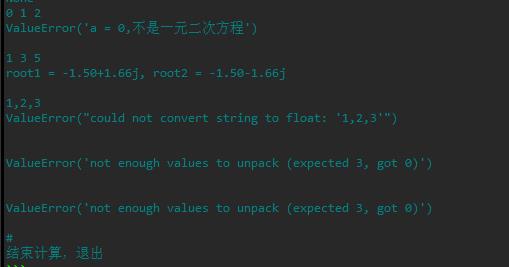
4.实验任务4
task4.py
运行源代码:
def list_generator(*n): if len(n)==2: a = n[0] b = n[1] return (list(range(a,b+1))) else: a = n[0] b = n[1] c = n[2] if c ==int(c): return (list(range(a,b+1,c))) else: ls = [a] while a<b: a = a+c ls.append(a) return ls list1 = list_generator(-5,5) print(list1) list2 = list_generator(-5,5,2) print(list2) list3 = list_generator(1,5,0.5) print(list3)
程序运行截图:

5.实验任务5
task5.py
实验源代码:
def is_prime(n): if n ==1: return False elif n ==2: return True else: for i in range(2,n): if n%i==0: break return False else: if i ==n-1: return True for i in range(4,21,2): print(\' = \'.format(i),end =\'\') t1 = 2 t2 = i-t1 while t2>=t1: if is_prime(t1) and is_prime(t2): print(\' + \'.format(t1,t2)) break else: t1+=1 t2-=1
运行程序截图:
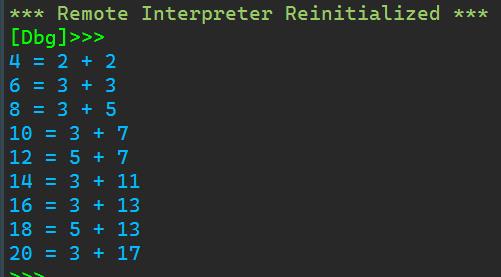
6.实验任务6
task6.py
程序源代码:
def encoder(n): ans = \'\' for i in n: if ord(i)>117: t = 97+5-123+ord(i) ans = ans + chr(t) elif ord(i)>=97 and ord(i)<=117: t = ord(i) + 5 ans = ans + chr(t) elif ord(i)<97 and ord(i)>85: t = 65+5-123+ord(i) ans = ans + chr(t) elif ord(i)<=85 and ord(i)>=65: t = ord(i) + 5 ans = ans + chr(t) else: ans = ans +i return ans def decoder(n): ans = \'\' for i in n: if ord(i)<102 and ord(i)>=97: t = 122-5+ord(i)-96 ans = ans + chr(t) elif ord(i)>=102 and ord(i)<=122: t = ord(i) - 5 ans = ans + chr(t) elif ord(i)<70 and ord(i)>=65: t = 90+5-ord(i)+65 ans = ans + chr(t) elif ord(i)>=70 and ord(i)<=90: t = ord(i) - 5 ans = ans + chr(t) else: ans = ans +i return ans text = input(\'输入英文文本: \') encoded_text = encoder(text) print(\'编码后的文本: \', encoded_text) decoded_text = decoder(encoded_text) print(\'对编码后的文本解码: \', decoded_text)
运行程序截图:
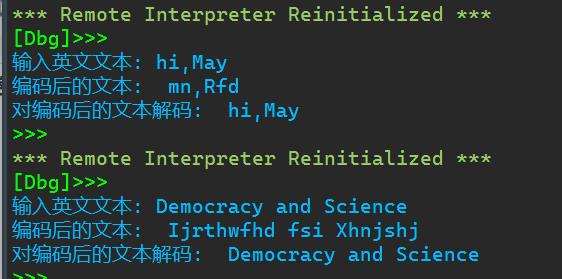
7.实验任务7
task7.py
程序源代码:
def collatz(n): ans = [n] while n !=1: if n%2 == 0: n = int(n/2) ans.append(n) else: n = n*3+1 ans.append(n) return ans while True: try: t = input(\'Enter a positive integer:\') if t.isdigit(): t = int(t) print(collatz(t)) break else: raise ValueError(\'Error: must be a positive integer\') except ValueError as f: print(f) break
运行程序截图:
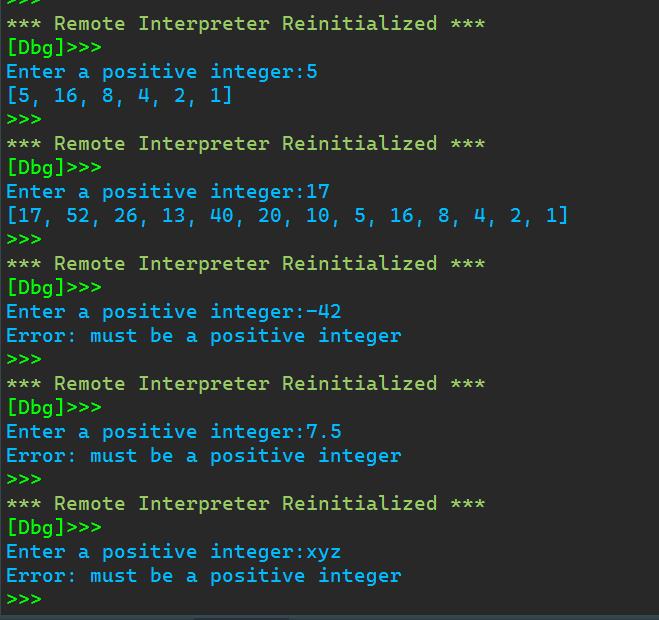
8.实验任务8
task8.1.py
程序源代码:
运行程序截图:
task8.2.py
程序源代码:
运行程序截图:
大数据Hadoop实验报告
文章目录
实验一 熟悉常用的Linux操作和Hadoop操作
1.实验目的
Hadoop运行在Linux系统上,因此,需要学习实践一些常用的Linux命令。本实验旨在熟悉常用的Linux操作和Hadoop操作,为顺利开展后续其他实验奠定基础。
2.实验平台
- 操作系统:Linux;
- Hadoop版本:2.7.1。
3.实验内容和要求
(一)熟悉常用的Linux操作
请按要求上机实践如下linux基本命令。
cd命令:切换目录
(1)切换到目录 /usr/local

(2)切换到当前目录的上一级目录

(3)切换到当前登录Linux系统的用户的自己的主文件夹

ls命令:查看文件与目录
(4)查看目录/usr下所有的文件

mkdir命令:新建新目录
(5)进入“/tmp”目录,创建一个名为“a”的目录,并查看“/tmp”目录下已经存在哪些目录
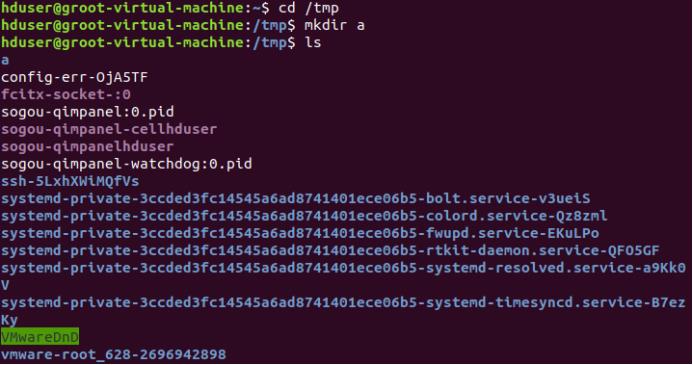
(6)进入“/tmp”目录,创建目录“a1/a2/a3/a4”

rmdir命令:删除空的目录
(7)将上面创建的目录a(在“/tmp”目录下面)删除

(8)删除上面创建的目录“a1/a2/a3/a4” (在“/tmp”目录下面),然后查看“/tmp”目录下面存在哪些目录

cp命令:复制文件或目录
(9)将当前用户的主文件夹下的文件.bashrc复制到目录“/usr”下,并重命名为bashrc1

(10)在目录“/tmp”下新建目录test,再把这个目录复制到“/usr”目录下

mv命令:移动文件与目录,或更名字
(11)将“/usr”目录下的文件bashrc1移动到“/usr/test”目录下

(12)将“/usr”目录下的test目录重命名为test2

rm命令:移除文件或目录
(13)将“/usr/test2”目录下的bashrc1文件删除
$ sudo rm /usr/test2/bashrc1

(14)将“/usr”目录下的test2目录删除
$ sudo rm –r /usr/test2

cat命令:查看文件内容
(15)查看当前用户主文件夹下的.bashrc文件内容

tac命令:反向查看文件内容
(16)反向查看当前用户主文件夹下的.bashrc文件的内容

more命令:一页一页翻动查看
(17)翻页查看当前用户主文件夹下的.bashrc文件的内容

head命令:取出前面几行
(18)查看当前用户主文件夹下.bashrc文件内容前20行

(19)查看当前用户主文件夹下.bashrc文件内容,后面50行不显示,只显示前面几行

tail命令:取出后面几行
(20)查看当前用户主文件夹下.bashrc文件内容最后20行

(21) 查看当前用户主文件夹下.bashrc文件内容,并且只列出50行以后的数据

touch命令:修改文件时间或创建新文件
(22)在“/tmp”目录下创建一个空文件hello,并查看文件时间

(23)修改hello文件,将文件时间整为5天前
chown命令:修改文件所有者权限

(24)将hello文件所有者改为root帐号,并查看属性

find命令:文件查找
(25)找出主文件夹下文件名为.bashrc的文件

tar命令:压缩命令
(26)在根目录“/”下新建文件夹test,然后在根目录“/”下打包成test.tar.gz

(27)把上面的test.tar.gz压缩包,解压缩到“/tmp”目录
$ sudo tar -zxv -f /test.tar.gz -C /tmp

grep命令:查找字符串
(28)从“~/.bashrc”文件中查找字符串’examples’

(29)请在“~/.bashrc”中设置,配置Java环境变量
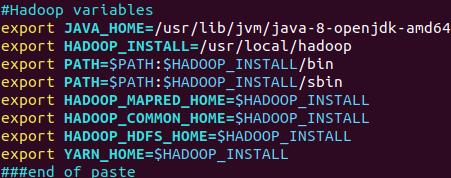
(30)查看JAVA_HOME变量的值

(二)熟悉常用的Hadoop操作
(31)使用hadoop用户登录Linux系统,启动Hadoop(Hadoop的安装目录为“/usr/local/hadoop”),为hadoop用户在HDFS中创建用户目录“/user/hadoop”

(32)接着在HDFS的目录“/user/hadoop”下,创建test文件夹,并查看文件列表

(33)将Linux系统本地的“~/.bashrc”文件上传到HDFS的test文件夹中,并查看test

(34)将HDFS文件夹test复制到Linux系统本地文件系统的“/usr/local/hadoop”目录下

实验二 熟悉常用的HDFS操作
1.实验目的
- 理解HDFS在Hadoop体系结构中的角色;
- 熟练使用HDFS操作常用的Shell命令;
2.实验平台
- 操作系统:Linux(建议Ubuntu16.04);
- Hadoop版本:2.7.1;
- JDK版本:1.7或以上版本;
- Java IDE:Eclipse。
3.实验步骤
(一)编程实现以下功能,并利用Hadoop提供的Shell命令完成相同任务:
(1)向HDFS中上传任意文本文件,如果指定的文件在HDFS中已经存在,则由用户来指定是追加到原有文件末尾还是覆盖原有的文件;
Shell命令:
追加到末尾
hadoop fs -appendToFile /usr/local/hadoop/test.txt /user/text.txt
覆盖原文件
hadoop fs -copyFromLocal -f /usr/local/hadoop/test.txt /user/text.txt
Java代码:
import org.apache.hadoop.conf.Configuration;
import org.apache.hadoop.fs.*;
import java.io.*;
public class HDFSApi
public static boolean test(Configuration conf, String path) throws IOException FileSystem fs = FileSystem.get(conf);
return fs.exists(new Path(path));
public static void copyFromLocalFile(Configuration conf, String localFilePath, String remoteFilePath) throws IOException
FileSystem fs = FileSystem.get(conf);
Path localPath = new Path(localFilePath);
Path remotePath = new Path(remoteFilePath); fs.copyFromLocalFile(false, true, localPath, remotePath);
fs.close();
public static void appendToFile(Configuration conf, String localFilePath, String remoteFilePath) throws IOException
FileSystem fs = FileSystem.get(conf);
Path remotePath = new Path(remoteFilePath);
FileInputStream in = new FileInputStream(localFilePath);
FSDataOutputStream out = fs.append(remotePath);
byte[] data = new byte[1024];
int read = -1;
while ( (read = in.read(data)) > 0 ) out.write(data, 0, read);
out.close(); in.close(); fs.close();
public static void main(String[] args)
Configuration conf = new Configuration(); conf.set("fs.default.name","hdfs://localhost:9000");
String localFilePath = "/home/hadoop/text.txt";
String remoteFilePath = "/user/hadoop/text.txt";
String choice = "append";
String choice = "overwrite";
try
Boolean fileExists = false;
if (HDFSApi.test(conf, remoteFilePath))
fileExists = true;
System.out.println(remoteFilePath + " 已存在.");
else
System.out.println(remoteFilePath + " 不存在.");
if ( !fileExists) // 文件不存在,则上传
HDFSApi.copyFromLocalFile(conf, localFilePath, remoteFilePath);
System.out.println(localFilePath + " 已上传至 " + remoteFilePath);
else if ( choice.equals("overwrite") ) // 选择覆盖
HDFSApi.copyFromLocalFile(conf, localFilePath, remoteFilePath);
System.out.println(localFilePath + " 已覆盖 " + remoteFilePath);
else if ( choice.equals("append") ) // 选择追加
HDFSApi.appendToFile(conf, localFilePath, remoteFilePath);
System.out.println(localFilePath + " 已追加至 " + remoteFilePath);
catch (Exception e)
e.printStackTrace();
(2)从HDFS中下载指定文件,如果本地文件与要下载的文件名称相同,则自动对下载的文件重命名;
Shell命令:
if $(hadoop fs -test -e /usr/local/hadoop/test.txt);
then $(hadoop fs -copyToLocal /user/test.txt /usr/local/hadoop/test.txt);
else $(hadoop fs -copyToLocal /user/test.txt /usr/local/hadoop/test2.txt);
Java代码:
Import org.apache.hadoop.conf.Configuration;
import org.apache.hadoop.fs.*;
import java.io.*;
public class HDFSApi
public static void copyToLocal(Configuration conf, String remoteFilePath, localFilePath) throws IOException
FileSystem fs = FileSystem.get(conf);
Path remotePath = new Path(remoteFilePath);
File f = new File(localFilePath);
if(f.exists())
System.out.println(localFilePath + " 已存在.");
Integer i = 0;
while (true)
f = new File(localFilePath + "_" + i.toString());
if (!f.exists())
localFilePath = localFilePath + "_" + i.toString();
break;
System.out.println("将重新命名为: " + localFilePath); ());
Path localPath = new Path(localFilePath);
fs.copyToLocalFile(remotePath, localPath);
fs.close();
public static void main(String[] args)
Configuration conf = new Configuration(); conf.set("fs.default.name","hdfs://localhost:9000");
String localFilePath = "/home/hadoop/text.txt";
String remoteFilePath = "/user/hadoop/text.txt";
try
HDFSApi.copyToLocal(conf, remoteFilePath, localFilePath);
System.out.println("下载完成");
catch (Exception e)
e.printStackTrace();
(3)将HDFS中指定文件的内容输出到终端中;
Shell命令:
hadoop fs -cat text.txt
Java代码:
import org.apache.hadoop.conf.Configuration; import org.apache.hadoop.fs.*; import java.io.*;
public class HDFSApi
/**
* 读取文件内容
*/
public static void cat(Configuration conf, String remoteFilePath) throws IOException
FileSystem fs = FileSystem.get(conf);
Path remotePath = new Path(remoteFilePath);
FSDataInputStream in = fs.open(remotePath);
BufferedReader d = new BufferedReader(new InputStreamReader(in)); String line = null;
while ( (line = d.readLine()) != null )
System.out.println(line);
d.close(); in.close(); fs.close();
public static void main(String[] args)
Configuration conf = new Configuration(); conf.set("fs.default.name","hdfs://localhost:9000");
String remoteFilePath = "/user/local/hadoop/text.txt"; // HDFS 路径
try
System.out.println("读取文件: " + remoteFilePath);
HDFSApi.cat(conf, remoteFilePath);
System.out.println("\\n 读取完成");
catch (Exception e)
e.printStackTrace();
(4)显示HDFS中指定的文件的读写权限、大小、创建时间、路径等信息;
Shell命令:
hadoop fs -ls -h /user/test.txt
Java代码:
import org.apache.hadoop.conf.Configuration; import org.apache.hadoop.fs.*; import java.io.*; import java.text.SimpleDateFormat;
public class HDFSApi
public static void ls(Configuration conf, String remoteFilePath) throws IOException
FileSystem fs = FileSystem.get(conf);
Path remotePath = new Path(remoteFilePath); FileStatus[] fileStatuses = fs.listStatus(remotePath); for (FileStatus s : fileStatuses)
System.out.println("路径: " + s.getPath().toString());
System.out.println("权限: " + s.getPermission().toString());
System.out.println("大小: " + s.getLen());
/* 返回的是时间戳,转化为时间日期格式 */
Long timeStamp = s.getModificationTime();
SimpleDateFormat format = new SimpleDateFormat("yyyy-MM-dd HH:mm:ss");
String date = format.format(timeStamp);
System.outprintln("时间: " + date); fs.close();
public static void main(String[] args) Configuration conf = new Configuration(); conf.set("fs.default.name","hdfs://localhost:9000");
String remoteFilePath = "/user/hadoop/text.txt";
try
System.out.println("读取文件信息: " + remoteFilePath);
HDFSApi.ls(conf, remoteFilePath);
System.out.println("\\n 读取完成");
catch (Exception e)
e.printStackTrace();
(5)给定HDFS中某一个目录,输出该目录下的所有文件的读写权限、大小、创建时间、路径等信息,如果该文件是目录,则递归输出该目录下所有文件相关信息;
Shell命令:
hadoop fs -ls -R -h /user
Java代码
import org.apache.hadoop.conf.Configuration; import org.apache.hadoop.fs.*; import java.io.*;
import java.text.SimpleDateFormat;
public class HDFSApi
/**
* 显示指定文件夹下所有文件的信息(递归)
*/
public static void lsDir(Configuration conf, String remoteDir) throws IOException
FileSystem fs = FileSystem.get(conf);
Path dirPath = new Path(remoteDir);
/* 递归获取目录下的所有文件 */
RemoteIterator<LocatedFileStatus> remoteIterator = fs.listFiles(dirPath, true);
/* 输出每个文件的信息 */
while (remoteIterator.hasNext())
FileStatus s = remoteIterator.next();
System.out.println("路径: " + s.getPath().toString());
System.out.println("权限: " + s.getPermission().toString());
System.out.println("大小: " + s.getLen());
/* 返回的是时间戳,转化为时间日期格式 */
Long timeStamp = s.getModificationTime();
SimpleDateFormat format = new SimpleDateFormat("yyyy-MM-dd HH:mm:ss");
String date = format.format(timeStamp);
System.out.println("时间: " + date);
System.out.println();
fs.close();
/**
* 主函数
*/
public static void main以上是关于实验4的主要内容,如果未能解决你的问题,请参考以下文章